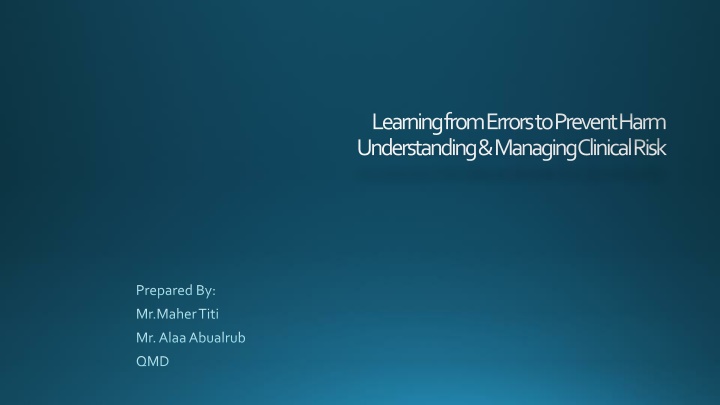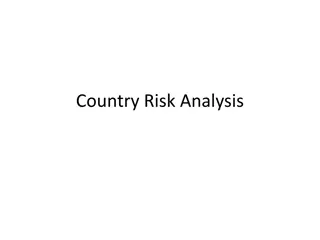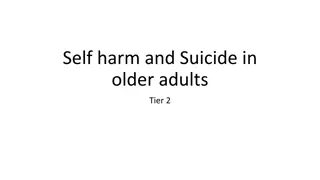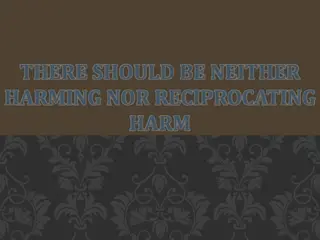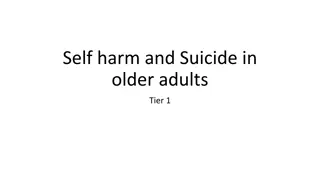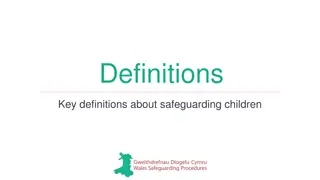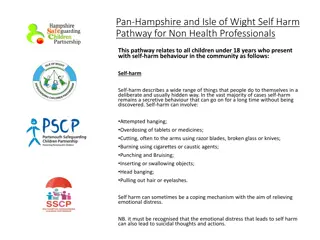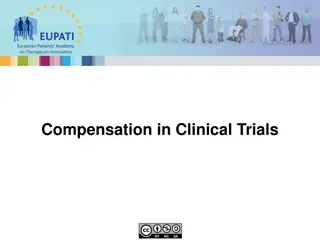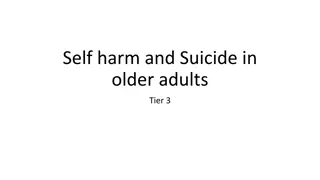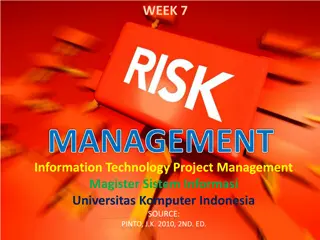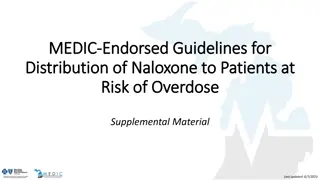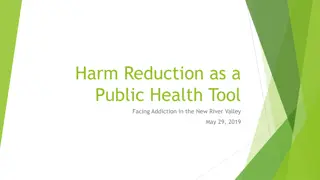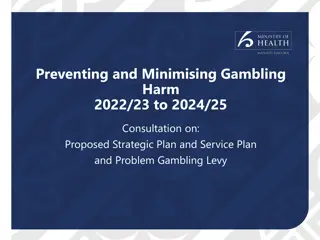Preventing Harm: Learning and Managing Clinical Risk
In this lecture by Mr. Maher Titi and Mr. Alaa Abualrub, the focus is on understanding the nature of errors in a clinical setting to prevent harm. The key objective is to equip individuals with the knowledge and skills needed to identify, manage, and learn from errors in healthcare practice, ultimately enhancing patient safety and quality of care.
Download Presentation

Please find below an Image/Link to download the presentation.
The content on the website is provided AS IS for your information and personal use only. It may not be sold, licensed, or shared on other websites without obtaining consent from the author.If you encounter any issues during the download, it is possible that the publisher has removed the file from their server.
You are allowed to download the files provided on this website for personal or commercial use, subject to the condition that they are used lawfully. All files are the property of their respective owners.
The content on the website is provided AS IS for your information and personal use only. It may not be sold, licensed, or shared on other websites without obtaining consent from the author.
E N D
Presentation Transcript
Learning from Errors to Prevent Harm Understanding & Managing Clinical Risk Prepared By: Mr.MaherTiti Mr. AlaaAbualrub QMD
Learning objective By end of this lecture you will be able to : Understand the nature of error. Define the following terms error, slip, lapse, mistake, violation, near miss, hazard, risk and Risk management. Understand how you can learn from errors. Identify situational and personal factors that are associated with the increased risk of error. Participate in analyses of adverse event and practice strategies to reduce errors. Know how to apply risk-management principles in the workplace. Know how to report risks or hazards in the workplace.
Principal Types of errors Errors :An error is a failure to carry out a planned action as intended. or the use of a wrong plan to achieve an aim. Errors may manifest by: Doing the wrong thing (commission) OR failing to do the right thing (omission). Example, Retained surgical instruments Violations:are errors caused by deliberate deviation by an individual from an accepted protocol or standard of care.
Principal Types of Human errors A mistake is a failure of planning (i.e. the plan is wrong). This can be either: Rule-based, when the wrong rule is applied, e,g: wrong diagnosis end with inappropriate treatment plan Knowledge-based, when a clinician does not take the correct course of action. e.g: when physicians are dealing with unfamiliar clinical situations
Principal Types of Human errors Skill-based slips error : if the action is observable e.gpushing the wrong button on a piece of equipment Skill-based lapse error : if the action is NOT observable e.ga memory failure, such as forgetting to administer a medication.
Types of Medical Errors Diagnostic Error or delay in diagnosis(in the case of the diabetic patient may lead to blindness or glaucoma) Use of outmoded tests or therapy Treatment Error in the performance of an operation, procedure, or test(inserting a breathing tube into a patient s esophagus ). Error in the dose or method of using a drug Preventive Failure to provide prophylactic treatment Inadequate monitoring or follow- up of treatment ( no order for anticoagulant post major orthopedic procedure may lead to PE). Other Failure of communication Equipment failure SOURCE: Leape, Lucian; Lawthers, Ann G.; Brennan, Troyen A., et al. Pr e-venting Medical Injury. Qual Rev Bull. 19(5):144 149, 1993. 9/15/2024 7
Concepts : A clinical incident: Is a deviation from standard of care and safety Examples: Medication errors Near miss: Is any situations that did not cause harm to patients (that did not reach the patient) , but could have done.
Factors Associated with an Increased Risk of Error Situations factors: Examples: Shortage of time Poor procedures preparation Individual factors: Examples: Fatigue Stress
Situations Associated with an Increased Risk of Error Inexperience: It is very important not to perform a procedure or administer a treatment for very first time without appropriate preparation. Shortage of time: Time pressures encourage people to cut corners and take shortcuts when they should not. e.g Not cleansing hands properly is an example of this.
Situations Associated with an Increased Risk of Error Inadequate checking: The simple act of checking saves thousands of patients from receiving the wrong medications. Poor procedures: Inadequate preparation, inadequate staffing and/or inadequate attention to the particular patient. Inadequate information: Misinformation, incorrect and inadequate information are often factors contributing to adverse events. Due to: Recoding the patient details inaccurately Illegible handwriting in the patient record
Individual factors that predispose to errors Limited memory capacity: Learning to ask for help is an essential skill Fatigue: Study by Landrigan et al found that interns working in the ICU,CCU of Brigham and Women s Hospital made substantially more serious mistakes when they worked frequent shifts of 24 hours or more as compared to when they worked shorter shifts.
Individual factors that predispose to errors Stress, hunger and illness: There are many mnemonic devices to help students monitor themselves. HALT is one such aid. H Hungry A Angry L Late or T Tired Another memory tool for self-monitoring is IM SAFE. I Illness M Medication (prescription and others) S Stress A Alcohol F Fatigue E Emotion
Individual factors that predispose to errors Language or cultural factors: communication errors caused by language and cultural factors is obvious Hazardous attitudes: Students who perform procedures or interventions for patients without supervision might be said to display a hazardous attitude.
Ways to learn from errors Incident reporting Incident reporting and monitoring involve collecting and analysing information about any event that could have harmed or did harm a patient in a clinical setting or health-care organization. Root Cause Analysis(RCA): Is a highly structured systemic approach to incident analysis RCA focuses on the system, not the individual
Case Studies-small Group Discussion A 58-year-old female was being treated for non-Hodgkin s lymphoma. Vincristine was prepared in a 20 ml syringe and delivered in a package containing two other drugs, including methotrexate. Route of administration was not indicated on the solutions. The intrathecal treatment was administered at noon. The haematologistwas particularly busy and requested help from another doctor who had not recently participated in intrathecal procedures. The medication was delivered in the patient s room. The nurse who assists was not familiar with the intrathecal procedures. The 20 ml syringe with vincristine was passed to the doctor who started to inject it. After administering approximately 2 ml, he noticed the size of the syringe and ceased administration realizing the error. The patient died approximately 100 days later.
Case Studies-small Group Discussion Identifying the care management problems Identifying the contributory factors Suggested actions
Introduction Risk management is routine in most industries and has traditionally been associated with limiting litigation costs Usually associated with patients taking legal action against a health professional or hospital To avoid problems, hospitals and health organizations use a variety of methods to manage risks hospitals are potentially dangerous places for patients as well as medical workers it s important to keep in mind that while there are a lot of potential hazards in hospitals,
Clinical risk management Hazard: is any activity, situation or, substance that potential to cause harm, including ill health, injury, loss of product and/or damage to plant and property. Bloodborne Pathogens Hazardous Chemicals Stress Risk: is the probability that harm (illness or injury) will actually occur. Risk Management: Organizational effort to identify, assess, control and evaluate the risk to reduce harm to patient, visitors and staff and protect the organization from financial loss
Purpose of Risk Management Improve organizational and client safety Identify and minimize the risks and liability losses Protect the organization resources Support regulatory, accreditation compliance Creating and maintaining safe systems of care, designed to reduce adverse eventsand improve human performance
Process Used to Manage Clinical Risks The following simple four-step process is commonly used to manage clinical risks: 1. Identify the risk; 2. Assess the frequency and severity of the risk; 3. Reduce or eliminate the risk; 4. Assess the costs saved by reducing the risk or the costs of not managing the risk.
Process Used to Manage Clinical Risks Identify the risk: Use the following data as a sources for risk identification: Adverse event reports. Mortality and morbidities reports. Patient complaints reports. Assess the frequency and severity of the risk;
Process Used to Manage Clinical Risks 2. Assess the frequency and severity of the risk: SAC (Severity Assessment Code) Score: it is a matrix scoring system/ numerical scores are given to the severity and likelihood of risks and these scores are multiplied to get a rating for the risk
Process Used to Manage Clinical Risks 3. Reduce or eliminate the risk:
Activities Commonly Used to Manage Clinical Risk Incident monitoring: An incident: as an event or circumstance that could have or did lead to unintended and/or unnecessary harm to a person and/or a complaint, loss or damage. Incident monitoring: refers to mechanisms for identifying, processing, analyzing and reporting incidents with a view to preventing their reoccurrence The key to an effective reporting system is for staff to routinely report incidents and near misses.
Activities Commonly Used to Manage Clinical Risk Sentinel events: Is usually unexpected and involving a patient death or serious physical or psychological injury to a patient e.g. surgery on the wrong patient or body site, incompatible blood transfusion. Many health-care facilities have mandated the reporting of these types of events because of the significant risks associated with their repetition
Activities Commonly Used to Manage Clinical Risk The role of complaints in improving care A complaint : is defined as an expression of dissatisfaction by a patient, family member or carerwith the provided health care. Complaints often highlight problems that need addressing, such as poor communication or suboptimal decision making. Communication problems are common causes of complaints, as are problems with treatment and diagnosis.
Benefits of complaints Assist the maintenance of high standards; Reduce the frequency of litigation; Help maintain trust in the profession; Encourage self-assessment; Protect the public.
Activities Commonly Used to Manage Clinical Risk Fitness-to-practice requirements Accountability Competency of healthcare professionals. Are they practicing beyond their level of experience and skill? Are they unwell, suffering from stress or illness Credentialing Registration (licensure) Accreditation
Credentialing The process of assessing and conferring approval on a person s suitability to provide specific consumer/patient care and treatment services, within defined limits, based on an individual s licence, education, training, experience, and competence.
Accreditation Is a formal process to ensure delivery of safe, high-quality health care based on standards and processes devised and developed by health-care professionals for health-care services. National Accreditation Program: CBAHI International Accreditation Program: Joint commission (US), Accreditation Canada(Canada)
Registration (licensure) Registration of health-care practitioners with a government authority, to protect the health and safety of the public through mechanisms designed to ensure that health practitioners are fit to practise. E.gSaudi Commission for Health Specialties Proper registration/licensure is an important part of the credentialing and accreditation processes
Personal Strategies for Managing Risk and Reduce Errors Care for one s self (eat well, sleep well and look after yourself); Know your environment; Know your task(s); Prepare and plan (what if...); Build checks into your routine; Practice the good documentation: A referral or request for consultation : it is important to only include relevant and necessary information: Keep accurate and complete health-care records Provide sufficient information Note any information relevant to the patient s diagnosis or treatment and outcomes; Document the date and time
Personal Strategies for Managing Risk and Reduce Errors Report any risks or hazards/incidents in your workplace Participate in meetings to discuss risk management and patient safety Respond appropriately to patients and families after an adverse event Respond appropriately to complaints Ask if you do not know. Request that a more experienced person
Summary Medical error is a complex issue, but error itself is an inevitable part of being human. These tips are known to limit the potential errors caused by humans Avoid reliance on memory Simplify process Standardize common processes and procedures Routinely use checklists Decrease reliance on vigilance Learning from error can occur at both an individual level and an organizational level through incident reporting and analysis. Root cause analysis (RCA) is a highly structured systemic approach to incident analysis that is generally reserved for the most serious patient harm episodes
Summary Health-care professionals are responsible for the treatment, care and clinical outcomes of their patients. Personal accountability is important, as any person in the chain might expose a patient to risk. One way for professionals to help prevent adverse events is to identify areas prone to errors. The proactive intervention of a systems approach for minimizing the opportunities for errors can prevent adverse events. Individuals can also work to maintain a safe clinical working environment by looking after their own health and responding appropriately to concerns from patients and colleagues.
